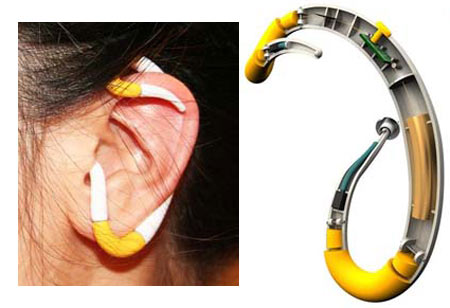
Sun Kyung Sunwoo, of the Sydney University of Technology has completely redesigned the hearing aid to make it a chic piece of jewelry that even outperforms traditional models.
Wirear is an innovation in both form and function. It involves a sleek form that provides flexibility with a multiply colour range to suit the market. Utilisation of emerging energy efficient, ‘micro fuel cell’ extends its usability.
The existing range of hearing aids is classified as: Completely-In-The-Ear, In-The-Canal, In-The-Ear and Behind-The-Ear. Wirear is a new type of hearing aid that is an alternative solution for a variety of hearing deficiencies. Wirear has successfully achieved innovation in both aesthetics and durability that is radically different to current solutions. The internal components are arranged in a linear form rather than stacked. In this format Wirear provides more space inside without adding bulk, resolving the issue of cramped components in a small housing, an identified problem with existing hearing aids.
Wirear utilises a micro fuel cell, a miniature version of fuel cell that uses hydrogen from any hydrocarbon fuel. This technology is yet to be commercialized however; it is a proven technology as the power source of the future. The mechanical flexibility of the micro fuel cell has allowed the design to be organic so that the form naturally flows with the shape of the ear.
The new form enhances usability and addresses a number of technical problems. The microphone is located in front of the ear, maximizing the opportunity of sound capture. The speaker is placed within the ear canal to reduce acoustic error resulting in improved sound quality and effectively decreasing the ‘echo’ sensation experienced when the close proximity of the speaker to the eardrum gives the sound a natural boost in volume. Another benefit of the distance between these elements is the reduction in auditory feedback.
